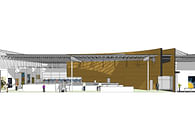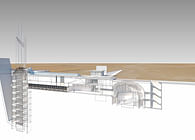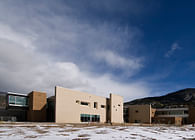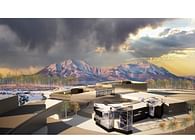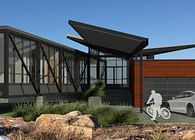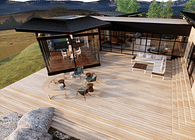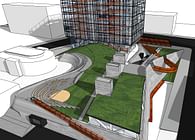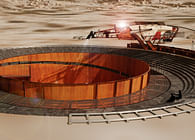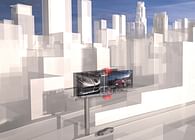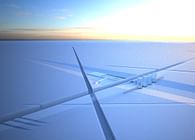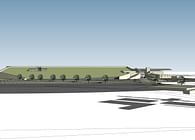
Colorado Springs, CO, US
UNIVERSITY OF CALIFORNIA - SAN DIEGO: SCHOOL OF BIOTECHNOLOGY AND GENETIC ENGINEERING - La Jolla Eco District, San Diego, California, USA (in progress - pending real estate acquisition)
Coming quickly to terms of all expression laid, Emotions revealed as the ocean maid. As a movement regained and regarded both the same,
All complete in the sight of seeds of life with you.
- Anderson/Bruford/Howe/Squire, “And You and I”, Close to the Edge, 1972
“We are only just beginning to question what our lives would look like if duality were no longer an antecedent to every discussion - up/down, left/ right, male/female, black/white, beginning/end. If dualistic definitives no longer define our concepts of existence, how do we see ourselves and the natural world around us? If our perception of the natural world is no longer restricted by these base prejudices of ‘either/or’, can the alternative found in a broad range of consideration begin to expand the possibilities of our experience?
Our path has traveled from low and humbled stations, where the struggle for daily survival consumed our every moment, to our current position of hubris, where our technologies have gained us the ability to alter our environment for our own comforts, concerns, and pleasures. As we begin to realize that our philosophical constructs, some of them centuries old, are in dire need of revision, we find that this revision requires far more than a simple adjustment in behavior. It requires a re-examination of the generative antecedents that drive some of our most fundamental beliefs, many of which have for centuries define the ontological nature of the human condition itself."
- Robert Mark Harris, Architect, excerpt from "Memories of the Ruined Landscape"
Preamble: Architecture is, as it always has been, a reflection of the intents and values of the culture which creates it. To this end, this projects seeks a merger between the technosphere of our creation and the biosphere of our inheritance.
Campus and Facility planning , the campus is proposed on one of the last remaining parcels of ocean-front real estate in La Jolla. Through it’s unique method of organization and programming, the project questions the role of both context and object. As such, the the projects treats both site and program ‘on par’ as generative form-giver. Hence, the project acts as an oscillating medium of exchange between the notions of object and form.
Program and Site Planning: If traditional campus planning models were employed, not only would the area requirements fill the entire site, but each college or department would be an independent (and isolated) building. This would in turn reveal an intent of prioritized dominance (ethics as applying solely to humans), as well as the notion that knowledge is compartmentalized and segregated.
In creating a combined school of several colleges, (genetics and biotechnology being primary), the campus is zone vertically rather than horizontally. Program is treated more as a ‘communicative liturgy’ than as a method of categorization.
Those currently in a holding patter relative to complex real estate negotiations, the project proposes over 650,700 square feet of programmed space on what is a environmentally and politically charged site. With traditional campus planning, the project would occupy over 68% of the total site, and would disturb up to 84% of the total site. To this end, the design team proposed a strategy of density that occupies less than 38% of the total land, and disturbed less than 42%, including utilities.
As such the site is planned as a series of excavated, sheltered, and embedded plazas that gently walk down and through the site, often following the well-worn footpaths left from generations of species, both human and other. Given it’s wind-blow sea-side location, vegetation is sparse and low - plants other than wild grasses are only possible in places that shelter from the continual winds. Interestingly, the site was first designed as a series of hollows, shelters, and hollows - a sculpted landscape where rarified gardens of occupation are the result of sheltered ‘precincts’. Buildings are therefore placed (and formed) to simultaneously block and direct the cool ocean winds for cooling, and to provide shading for communal gathering spaces and gardens. Much as a ‘landscape art’ artists, the project works to a subjugation of the ground plan, thus establishing a wide range ‘floor planes’, but always relative to the embedded physical and spiritual aspects of the site.
Buildings are programmed as ‘earth-bound’ or ‘sky-bound’, with materials reflecting their programmatic intentions and purposes. Through an innovative integration of fenestrations, structures, and mechanical systems, the buildings work more towards erasure than toward occupation.
Path and procession are key elements in experiencing the building, with program serving as a complex amalgamation that one experiences as one simultaneously moves through both building and site. In this manner, program is dispersed rather than isolated, more reflective of the interconnected and inter-relational nature of the curriculum than of distinct departmental precincts. The client’s programmatic imperative of ‘architecture of ethics’, therefore, allows all genetic and biotechnological studies to continually live within a mutual ‘check and balance’ between a multitude of departments (rather than operating in departmental isolation). Interestingly, walk-time between curricular classes can be reduced, as can overall access convenience between shared resources (such as research library, computer labs and lecture halls).
The campus is zoned both horizontally and horizontally. Therefore, not only is program dispersed relative to curriculum (as a collaborative imperative), but circulation ‘in, through, and around’ program becomes a point of departure for a more fluid definition of ‘public and private’. To this end, the circulation itself allows one to move ‘in, through, and around’ the buildings as a form of public walkway - never penetrating a private area, but also not designating a building as a totally private precinct. In this way, anyone may experience the site from all vantage points without breeching the sanctity of those areas where privacy is sacrosanct. In our current world of ‘card keys’, this gives any student (or visitor) access to architecture’s ability to interpret both it’s program and it’s site in meaningful ways. As such, the ‘public/private’ barrier is simultaneoulsly preserved and expanded.
Structural Elements:A study in integration rather than separation, the project’s structural systems seeks to reveal the complex inter-relationships of spatial determinants rather than simply defining space for use. As such, structure becomes a tool for spatial self-analysis, inter-twining it’s own physical aspects into the primary spatial configurations of each programmatic element. In this manner, human occupation is prioritized, but it’s prioritization is subject to a greater systemic context.
The NURBS walls form the core of each major building, providing both lateral bracing and seismic stability. Each NURBS wall is a graphic realization of programmed elements (parabolic rather than euclidian analysis), and holds the core mechanical and circulatory elements of the buildings. The high-performance double-fenestration ‘mechanical’ skins move all air throughout the laboratory/research buildings, and is attached to a structural system that is akin to a space-frame tilted on it’s ends. Major space-frame struts tie back to the concrete NURBS core walls while also providing a floor-beam system for suspended laboratory and library floors. In this way, the fenestration, space-frame, and NURBS core act as a singe unit composed of a multitude of individual yet symbiotic ‘components’.
A key programmatic element is the library (seen above), uniquely planned as a vertical space with multiple access points to reflect it’s shared and collaborative nature within the overall campus.
Status: Unbuilt
Location: San Diego, CA, US
My Role: Principal, Lead Design Architect, Project Architect
Additional Credits: Ryan Ekstrom, Richard Mapes, Kenny LaGreca (structural engineer)

